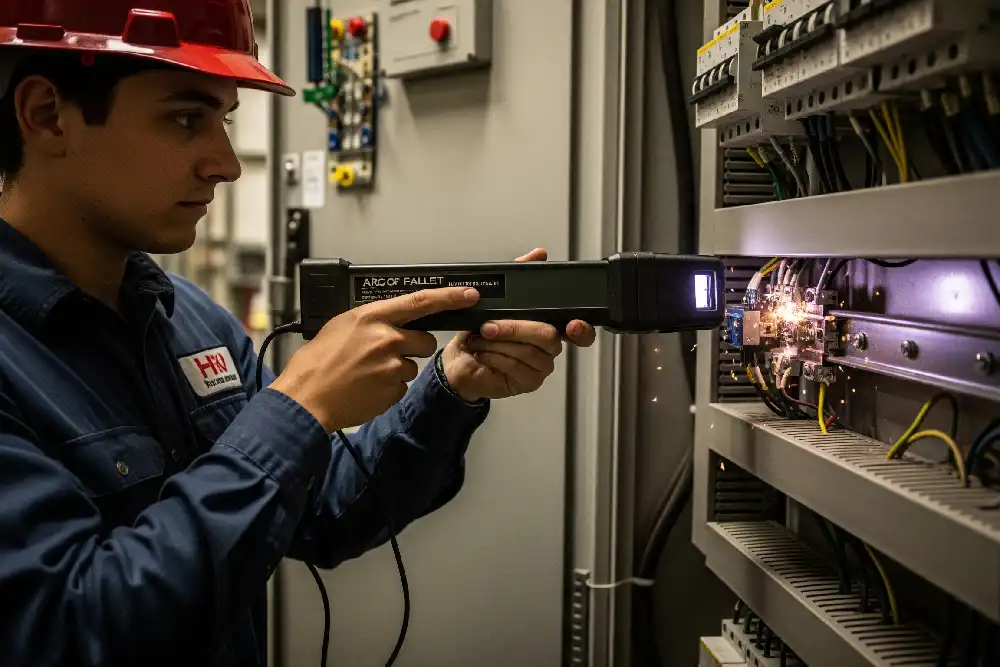Keeping your home safe means finding electrical problems early. Electrical faults cause about 51,000 house fires each year. Arcing faults start over 28,000 of these fires. You face many dangers if you miss an arc fault:
| Type of Hazard | Description |
|---|---|
| Electric Shock | Touching live electrical parts can shock you and cause bad injuries. |
| Burns | Touching hot equipment or arc flashes can burn you badly. |
| Arc Flash/Blast | A sudden burst of energy can explode, causing burns and injuries. |
| Fire Risks | Bad wiring or too much power can start fires and put people and homes in danger. |
| Severe Burns | Arc flash can cause very bad burns from strong heat. |
| Eye Injuries | The bright light from an arc flash can hurt your eyes. |
| Hearing Loss | The loud blast from an arc flash can hurt your ears. |
You can use simple steps to look for problems, but call an expert if you are not sure.
Key Takeaways
- Watch for warning signs of arc faults, like buzzing sounds, lights that flicker, or burning smells. These signs can help you find problems early.
- Always put safety first. Wear safety gear and turn off the power before you check electrical systems. This helps protect you from shocks and burns.
- Use the right tools, such as AFCI testers and thermal imaging cameras, to find hidden arc faults. These tools help you spot problems that could cause fires.
- Write down what you find during inspections. Taking notes helps you keep track of problems and gives information to professionals if you need help.
- If you see big problems like burning smells or broken outlets, turn off the power and call a licensed electrician right away.
Arc Fault Signs

Common Symptoms
You can spot an arc fault by watching for certain warning signs in your home. These signs often show up before bigger problems happen. If you notice any of these, you should take action right away:
- Buzzing, sizzling, or cracking noises from light switches or outlets
- Flickering lights that do not stop when you change bulbs
- A burning smell near electrical fixtures or outlets
- Warm or discolored outlets or switch plates
- Small sparks or visible flashes when you plug in or unplug devices
- Frequent breaker trips that seem to happen without a clear reason
Tip: Trust your senses. If you hear odd sounds, see sparks, or smell something burning, you may have an arc fault. These signs can mean your wiring is damaged or frayed, which can lead to fires.
Differentiating Arc Faults
You might wonder how to tell an arc fault apart from other electrical problems. Each type of fault has its own cause and risk. Here is how you can spot the difference:
- Arc Faults: These happen when damaged or frayed wires create sparks or arcs. You may see small flashes or hear buzzing. Arc faults often lead to fires if you ignore them.
- Ground Faults: These occur when electricity escapes to the ground. You might get a shock or see a breaker trip. Ground faults can also cause fires, but they usually involve water or damp areas.
- Short Circuits: These happen when current takes a shortcut back to the power source. You may notice a breaker trip right away. Short circuits create a lot of heat and can start fires quickly.
Note: Professionals use special tools like frequency domain analyses and waveform analyses to find arc faults. Most home breakers cannot detect arc faults early, so you need to stay alert for these warning signs.
Safety Preparation
Precautions
You must keep yourself safe before checking for arc fault problems. Electricity is very dangerous, so always be careful. First, look around your electrical panel. Check for water, burn marks, or anything strange. Do not touch the panel if you see any water.
Wear personal protective equipment (PPE) every time you check circuits. Use insulated gloves, flame-resistant clothes, safety shoes, a hard hat, and eye protection. These items protect you from shocks, burns, and flying pieces. Safety glasses and rubber gloves are very important when you open a panel.
Tip: Always look for damage, loose parts, burning, or arcing before touching any switch or device. If you find something turned off, ask the owner before turning it back on.
Clear away any clutter or trash in the area. Read the instructions for any arc fault detection device you want to use. If you do not feel sure about the wiring or panel, stop and call an expert.
Required Tools
You need the right tools to find arc faults safely and well. Here are some important tools for your check:
- Arc Fault Detection Devices (AFDDs): These can find dangerous arcing and help stop fires. They work by finding and stopping circuits before damage happens.
- AFCI testers: These check if your arc fault circuit interrupters work right.
- Multimeter: This tool checks voltage and current in your circuits.
- Oscilloscope: Use this to see the shapes of electrical signals. It helps you find odd patterns from arc faults.
- CO monitor: This checks for carbon monoxide, which can mean wires are burning.
| Detection Method | Effectiveness | Notes |
|---|---|---|
| AI-based approaches | Excellent outcomes | Focus on series arc faults, consider voltage and current changes. |
| Traditional methods | Varies | Use arc data as current, not many studies on voltage and current together. |
Note: AFDDs are very helpful in homes with lots of appliances. They help stop fires by finding arc faults early.
Device and Circuit Testing
Unplugging Devices
You need to unplug devices before you start testing for electrical problems. This step keeps you safe and helps you find the source of trouble. Follow these steps to unplug devices and test outlets safely:
- Shut off the breaker to the circuit you want to check. This stops the flow of electricity and protects you from shock.
- Remove the outlet you think is the first one in the circuit. Use insulated tools and wear protective gear.
- Cap the wires with wire nuts to prevent accidental contact.
- Turn the breaker back on.
- Test the other outlets by plugging in a work light or lamp. If you picked the right outlet, all the others on that circuit will be dead.
- If the outlets still work, replace the original outlet and repeat the process with another outlet until you find the first one in the circuit.
Tip: Always label the outlets and breakers as you work. This helps you keep track and avoid confusion later.
This method helps you find which outlets connect to each circuit. It also lets you check if a certain device or outlet causes the problem.
Isolating Circuits
Isolating circuits helps you find the exact location of an arc fault. You improve safety and make your search more accurate when you test one circuit at a time. Here are some best practices for isolating circuits:
- Turn off all breakers except the one you want to test. This reduces the risk of shock and makes it easier to spot problems.
- Use Arc Fault Detection Devices (AFDDs) to check for dangerous arcing. These tools can find faults that regular breakers miss.
- Do a hazard assessment before you start. Look for signs of damage, heat, or burning. Wear your safety gear and keep your work area clear.
You can also follow a step-by-step process to narrow down the source of the problem:
- Isolate the inverter terminals to block current flow. This can help stop series arc faults.
- Watch for abnormal patterns in the output waveforms. These patterns can show you where the fault is.
- Listen for arcing noise and check for a drop in array current. This often means you have a parallel arc fault.
- If you hear arcing noise near the open circuit voltage, you may have a parallel arc.
Note: Isolating circuits one by one takes time, but it helps you find the problem without guessing.
You can use AFCI testers to check if your breakers trip when they should. The table below shows how often different breakers trip during tests:
| Breaker Type | Percent of Tripped Breakers |
|---|---|
| Standard circuit breakers | 28% |
| AFCI breakers | 23% |
| Fuses | 18% |
| GFCI breakers | 17% |
| Dual function AFCI / GFCI breakers | 14% |
Key Fact: In a recent study, 74% of contractors saw dangerous arcing during AFCI service calls. Using the right tools and isolating circuits can help you find and fix these hazards before they cause damage.
Inspect Wiring and Outlets
Visual Damage
You can find early electrical problems by looking at your wiring and outlets. First, turn off the power in the area you want to check. Use a flashlight to look at all wires, outlets, and junction boxes you can see. Watch for these warning signs:
- Discoloration around wires or outlets
- Melted connectors or insulation
- Burned junction boxes on the back of panels
- Burn marks or scorch marks on wires or nearby surfaces
- Charred or melted insulation
- Pitted or eroded wire surfaces
- Curved or bent wires that look out of place
- A strong smell of ozone or burning plastic
Tip: If you see any of these signs, do not touch the wires. These problems often mean the wiring got too hot or had an arc fault. You should act fast to stop a fire or injury.
Here is a table to help you spot the most common signs of wiring damage:
| Indicator Type | Description |
|---|---|
| Discoloration | Changes in color of wiring and racking |
| Melted Connectors | Damage to connectors and insulation due to heat |
| Burned Junction Boxes | Evidence of severe overheating at junction points |
Thermal imaging cameras help you find hidden heat damage. These cameras show hot spots and temperature changes in your electrical system. You can use them to find loose connections, overloaded circuits, or bad parts. Checking with thermal imaging often can help you find problems early and stop fires.
Arc Fault Testing Tools
You can use special tools to find arc faults that are hard to see. Arc mapping and oscilloscopes are two good choices.
Arc mapping helps you follow the path of electrical faults in tricky wiring. Here is how it works:
- When a fire or fault hits live wiring, the insulation burns and chars.
- The charred insulation makes a path that lets current flow between wires.
- Enough current flow causes arcing, which you might see as flashes or sparks.
Arc mapping lets you study the electrical system and find where the problem started. This method works well for finding where a fire or hidden arc fault began.
Oscilloscopes let you see the shapes of electrical signals. You can use them to spot odd patterns in current and voltage. These patterns often show up when an arc fault is there. By checking the waveforms, you can find the exact spot where the electrical flow changes.
Note: Oscilloscopes help you find problems that regular testers might miss. They show you how electricity moves through your wires.
Thermal imaging also helps you find heat damage. It shows temperature changes on surfaces, so you can see where wires or outlets get too hot. You do not need to touch the wires, which keeps you safe while checking.
- Thermal imaging finds hot spots and temperature changes.
- It helps you find loose connections and overheating.
- You can stop equipment failures and fires by using it often.
Safety Reminder: Always wear protective gear and turn off power before you check or test wiring. If you find bad damage, call a licensed electrician right away.
Document and Next Steps
Tracking Results
You should write down what you do during your arc fault check. Keeping good notes helps you remember what you looked at. It also helps if you need to tell an expert later. One easy way to keep track is by using an electrical cabinet monitor. This device goes inside your electrical panel or on a wall close by. It looks for arcing in the air and saves the information. The monitor works all the time, so you do not have to watch it. You will not miss any events because it records them for you.
| Method of Inspection | Description | Benefits |
|---|---|---|
| Electrical Cabinet Monitor | Put on the inside of a door or wall, finds arcing by scanning the air. | Always checks for problems, does not need a person, keeps records for you. |
You can also use a notebook or a computer file. Write the date, place, what you saw, and what you did. Take pictures if you see damage or something strange. These notes help you find patterns and show an electrician what happened.
Tip: Keep your notes safe. Add new notes every time you check your wiring or outlets.
When to Call a Pro
Some problems mean you need an electrician right away. Do not ignore these warning signs. If you see or smell something that could mean fire, act quickly.
- A fishy or burning smell near outlets or switches
- Outlets that look burned or melted
- Smoke coming from electrical fixtures
If you see any of these, turn off the power at the fuse box. Wait for an expert to look at the problem.
You also need help if your AFCI breaker does not trip when you test it. This could mean a hidden problem that only an electrician can fix.
- AFCI breaker does not open the circuit after testing
Safety Alert: If you are not sure, always stay safe. Call a professional if you feel worried or see bad damage.
You can keep your home safe by following each step. Watch for arc fault signs and stay alert. Safety should always come first. Arc Fault Circuit Interrupters, or AFCIs, help stop electrical fires. AFCIs watch your wiring and turn off power if they find dangerous arcing. The National Electrical Code says you must have AFCIs in bedrooms and living rooms.
- AFCIs can stop fires before they begin.
- They help protect your family and your home.
| Benefit | Description |
|---|---|
| Enhanced Fire Prevention | Using AFCIs can cut electrical fires by half. |
| Protection of Equipment | Your electrical system lasts longer and costs less to fix. |
| Improved Personnel Safety | You are less likely to get hurt by arc flashes. |
| Regulatory Compliance | You follow the latest electrical codes and avoid getting fined. |
| Operational Efficiency | You can keep your system working and avoid problems. |
If you think there is an arc fault, act fast and call a professional for help.
FAQ
What should you do first if you suspect an arc fault?
Turn off the power to the area right away. Check for any signs of burning or damage. Do not touch wires or outlets until you know it is safe. If you feel unsure, call a licensed electrician.
Can you fix an arc fault yourself?
You can check for signs and unplug devices. You should not try to repair wiring or outlets unless you have electrical training. Always call a professional for repairs or if you see serious damage.
How often should you check your wiring for arc faults?
Check your wiring and outlets at least once a year. Use a flashlight to look for damage. Test your AFCI breakers every month. Regular checks help you find problems before they become dangerous.
What tools help you find arc faults?
You can use AFCI testers, arc fault detection devices, and thermal imaging cameras. These tools help you spot hidden problems. Always read the instructions before using any tool.
Why do AFCI breakers trip so often?
AFCI breakers trip when they sense dangerous arcing. Sometimes, they trip because of faulty devices or loose connections. If your breaker trips often, check your devices and call an electrician if the problem continues.
See also
How to Identify Arc Faults in Circuit Breakers for Home Safety
How to determine if the AFCI circuit breaker is damaged?
Arc fault circuit breaker and ground fault circuit breaker
What Is an Arc in a Circuit Breaker and Why Does It Matter
Essential Guide to Troubleshooting Household Circuit Malfunctions



